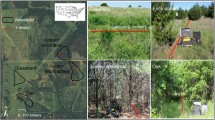Abstract
The water table in many intermittent wetland areas can rise greatly with a small amount of infiltration. Three intermittent wetland areas in eastern North Dakota show how hydrological conditions relate to changes of the water table. Two processes, air entrapment beneath an inverted water table and infiltration into the capillary fringe can cause the water table to rise more than ten times the amount of infiltration. Although run-off may provide the primary contribution to surface water volume in some intermittent wetlands, surface water may also accumulate during minor precipitation in wetlands where the capillary fringe is near or intersects the ground surface. Air-filled pores only constitute a small fraction of total porosity in most wet, fine-grained soils of intermittent wetlands. With a small amount of infiltration, surface water may accumulate when the thick fringe of tension saturation above the water table is changed to pressure saturation. Small values of air-filled porosity also influence the estimate of actual evapotranspiration made from shallow well hydrographs. The use of specific yield in formulas leads to an excessively large rate of actual evapotranspiration, but estimates can be improved by using a ratio of water-level rise to infiltration for the storage factor. Established methods of analysis are also improved by using both the recession and recovery slope of the diurnal cycle shown on the hydrograph.
Similar content being viewed by others
Literature Cited
Bianchi, W. C. and E. E. Haskell, Jr. 1966. Air in the vadose zone as it affects water movements beneath a recharge basin. Water Resources Research 2:315–322.
Campbell, G. S. 1985.Soil Physics With BASIC. Developments in Soil Science 14, Elsevier, New York, NY, USA.
Davis, S. N. and R. J. M. DeWeist. 1966.Hydrogeology. John-Wiley and Sons, Inc., New York, NY, USA.
deMarsily, G. 1986.Quantitative Hydrogeology—Groundwater Hydrology for Engineers. Academic Press, Inc., Orlando, FL, USA.
Freeze, R. A. and J. A. Cherry. 1979.Groundwater. Prentice-Hall Inc., Englewood Cliffs, NJ, USA.
Gillham, R. W. 1984. The capillary fringe and its effect on watertable response. Journal of Hydrology 67:307–324.
Meyboom, P. 1967. Groundwater studies in the Assiniboine River drainage basin: II. Hydrologic characteristics of phreatophytic vegetation in south-central Saskatchewan. Geological Survey of Canada Bulletin 139.
National Research Council. 1991.Opportunities in the Hydrologic Sciences. National Academy Press, Washington, DC, USA.
Robinson, T. W. 1958. Phreatophytes. U.S. Geological Survey Water-Supply Paper 1423.
Troxell, H. C. 1936. The diurnal fluctuation in the ground-water and flow of the Santa Ana River and its meaning. p. 496–504.In American Geophysical Union, Transactions, 17th Annual Meeting, Pasadena, CA, USA.
White, I. D., D. N. Mottershead, and S. J. Harrison. 1984.Environmental Systems—An Introductory Text. Allen and Unwin Inc., Winchester, MA, USA.
White, W. N. 1932. A method of estimating ground-water supplies based on discharge by plants and evaporation from soil. U.S. Geological Survey Water-Supply Paper 659-A.
Author information
Authors and Affiliations
Rights and permissions
About this article
Cite this article
Gerla, P.J. The relationship of water-table changes to the capillary fringe, evapotranspiration, and precipitation in intermittent wetlands. Wetlands 12, 91–98 (1992). https://doi.org/10.1007/BF03160590
Received:
Revised:
Accepted:
Issue Date:
DOI: https://doi.org/10.1007/BF03160590




